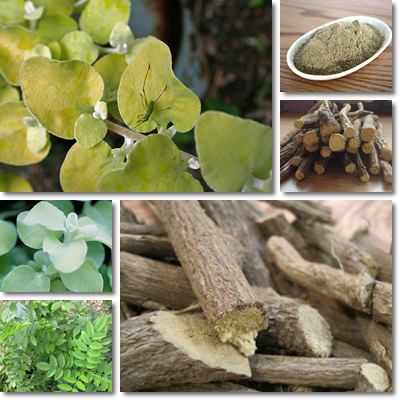The root of the plant with the same name, licorice or liquorice (Glycyrrhiza glandulifera) is not only a popular natural flavoring, but also a powerful herb with a wide range of health benefits. Licorice boasts excellent hepatoprotective properties and is a mild natural laxative. Its most impressive action is on the digestive system, having a soothing effect for a variety of different types of digestive upset. Licorice helps relieve heartburn and indigestion, improves stress resistance, reduces inflammation and protects against tooth decay and gum problems.
Studies suggest that it is highly efficient against the common cold, helps improve flu symptoms, calms cough and may even help in the prevention of more serious conditions such as bronchitis and tuberculosis as a result of its antimicrobial properties. At the same time, preparations from licorice are known to raise blood pressure levels which is why it is recommended that anyone with hypertension consume licorice infrequently to minimize side effects. Pregnant women with a risk of preeclampsia are advised to avoid it too.

What is licorice and what does it look like?
Licorice means ‘sweet root’ and refers to both the licorice plant, a flowering plant with beautiful pale purple flowers and seed pods, and its commercially valuable root, often referred to simply as licorice. The root looks very much like an average stick with a dull brown outer bark and a creamy white inner bark. Licorice root is either slivered, hence the name licorice slivers, or used as a natural flavoring in candied sweets, drinks, herbal infusions in particular, as well as tobacco byproducts.
What does licorice (root) taste like?
Real licorice, a.k.a. the freshly dug and cleaned root, has a strong bitter taste most people might find a bit too intense. When used in low concentrations in herbal infusions, for example, licorice leaves a pleasant, lingering sweetness in the back of one’s mouth, as a sort of delicate aftertaste. It has a classy flavor, quite different from that of sugared candy which overwhelms one’s taste buds from the start.
Black licorice is actually a licorice-flavored candy with added sugars and binders making the candy chewy. Because of various additives, it may pose serious health problems in the long run. Eating more than 50-100 g of black licorice per week is said to negatively affect potassium levels and cause hypertension, palpitations, extrasystoles, edema (swelling), shortness of breath and other more serious side effects.

What is licorice good for?
Licorice is quite a versatile medicinal herb, suited for a variety of affections ranging from stomach problems to viral infections, asthma, high blood lipid levels, dental cavities, constipation, inflammation and liver regeneration. The main active ingredient responsible for such a variety of uses is glycyrrhizin (glycyrrhizinic acid), a potent natural compound widely used in modern medical treatments. Find out below what are the top 10 uses of licorice:
Heartburn, stomach ulcers and indigestion
Because of its soothing properties, licorice is recommended for alleviating stomach problems such as acid reflux, bloating, heartburn, indigestion, irritated gastric mucosa or peptic ulcer pain. Find out more about what foods to eat and to avoid for acid reflux.
Viral infections
Licorice is a natural expectorant, meaning it helps clear phlegm and mucus from the airways and lungs. It is also known to help soothe common cold and flu symptoms such as cough and sore throat, alleviate muscle aches and combat fatigue via its cardiovascular effects by inducing alertness. Moreover, it has been shown to have an inhibitory effect on various influenza viruses, potentially helping reduce infection risk and viral load.
Fungal infections
Some studies suggest that licorice may be efficient against skin, mouth and yeast infections caused by various pathogenic fungi. However, remember it does not substitute antifungal medication and should not be relied on for the treatment of fungal infections.
Asthma and allergies
Eating small to moderate amounts of licorice root or drinking licorice tea is said to help manage asthma and allergy symptoms. Because of its mild antihistaminic effect, it is believed to help alleviate hay fever symptoms, allergic rhinitis, bronchial asthma and allergic conjunctivitis.
Boosting immunity
The main constituent of licorice, glycyrrhizinic acid, is an efficient natural anti-inflammatory and antiviral agent. Glycyrrhizinic acid was shown to increase interferon levels, hence the efficiency of the herb in the treatment of the common cold and flu and allergy management. Interferon is a (glyco)protein our body produces in the presence of pathogens such as viruses, bacteria and parasites which stops pathogens from spreading and infecting other cells.
Liver regeneration
Licorice possesses rather impressive hepatoprotective properties as a result of its glycyrrhizinic acid content. When administered intravenously, glycyrrhizinic acid extract has been shown limit the spread of hepatitis causing viruses responsible for liver inflammation, scarring and, ultimately, cirrhosis. Its antiviral and anti-inflammatory action promote liver regeneration.
Stress management
A moderate consumption of licorice is said to help improve natural stress coping mechanisms by inducing relaxation and relieving stress.
Tooth loss prevention
Special compounds in licorice (licoricidin and licorisoflavan A) were found to fight bacteria responsible for tooth decay and gum disease. In addition to preventing cavities and tooth loss, licorice root helps improve bad breath as well.
Constipation
Licorice boasts mild laxative properties and thus helps relieve constipation naturally. Herbal infusions are great at regulating intestinal transit and can be used in combination with various herbs such as senna leaves for a more potent effect.
Other health benefits
Research has revealed that licorice root may help prevent and improve the following conditions: gout, depression (due to the root containing phytoestrogens), psoriasis, shingles, arthritis, fatigue, tendinitis, arthritis (anti-inflammatory properties), tuberculosis and hair loss.
Side effects and contraindications
Licorice boasts wonderful anti-inflammatory, antiviral, antifungal and hepatoprotective properties, showing promising results in a number of medical conditions ranging from asthma, allergies and arthritis to heartburn, indigestion, peptic ulcers, tooth decay, liver problems and stress management. However, intake should be limited to no more than 0.5-1 g a day for no more than 1-2 consecutive weeks. If consumed in excess, it may cause unpleasant or even serious side effects such as low potassium blood levels leading to palpitations, hypertension, edema (swelling), extrasystoles and other cardiovascular manifestations.
Pregnant women are advised to avoid licorice during pregnancy or, at least, consult a physician prior to including it in their diet (especially if they haven’t had it before). People suffering from high blood pressure (hypertension) or on diuretics should also avoid the herb because it depletes the body of potassium which, in turn, causes high blood pressure and water retention. If you are experiencing kidney problems, it’s advised to avoid licorice as well.
